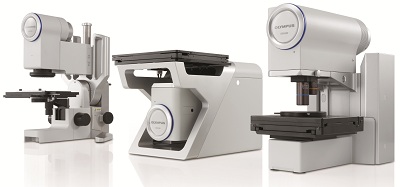OLYMPUS reports that the use of microscopes is expanding in a number of industrial sectors, as the needs of advanced metrology and quality control become more sophisticated. The company also notes that the users of microscopes in these industrial settings may have little formal training or experience with microscope technologies.
Its new DSX portfolio of microscopes has been launched with this market firmly in mind. The three models in the range – the DSX100 free-angle wide zoom microscope, DSX500 upright microscope, and DSX500i inverted microscope – are aimed at inspection and quality control users in a range of industrial sectors. The company says they offer operating simplicity along with absolute performance reliability.

New DSX series of inspection microscopes from Olympus: no eyepieces, no eyestrain
The first thing most users will notice is that these microscopes have no eyepieces, but rather they rely on computer monitors to visualise the objects under scrutiny. In fact, the microscopes can be entirely controlled by computer mouse or the touchscreen interface.
This approach is said to be more ergonomic and, because all three models in the range are operated the same way, users can move from one to another without needing any specific training.
The preview screen offers a choice of technique – brightfield, darkfield, and differential interference contrast (DIC) – and the system automatically generates a selection of preview images for each of these. The user then simply touches the screen to select their preferred imaging method.
All of this takes place within one of three operational modes – tutorial, operator, or advanced mode. As the name suggest, tutorial mode provides extra assistance to new operators, while operator mode allows customisation so that only the required functionality is visible for routine work. Advanced mode provides additional flexibility to a user with sufficient knowledge.
Olympus says the new zoom optics fitted to these microscopes reduce halation and glare, and this combined with sophisticated image processing gives precise, accurate and repeatable measurements. It is targeting inspection and analysis within manufacturing industries including automotive and electronic, as well as scientific users in palaeontology and geology, as the likely customers of this new range of microscopes.
